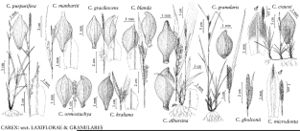Difference between revisions of "Carex gholsonii"
Novon 12: 524, fig. 6. 2002.
FNA>Volume Importer |
FNA>Volume Importer |
||
| Line 32: | Line 32: | ||
-->{{#Taxon: | -->{{#Taxon: | ||
name=Carex gholsonii | name=Carex gholsonii | ||
| − | |||
|authority=Naczi & Cochrane | |authority=Naczi & Cochrane | ||
|rank=species | |rank=species | ||
| Line 47: | Line 46: | ||
|publication year=2002 | |publication year=2002 | ||
|special status= | |special status= | ||
| − | |source xml=https://jpend@bitbucket.org/aafc-mbb/fna-data-curation.git/src/ | + | |source xml=https://jpend@bitbucket.org/aafc-mbb/fna-data-curation.git/src/f50eec43f223ca0e34566be0b046453a0960e173/coarse_grained_fna_xml/V23/V23_809.xml |
|genus=Carex | |genus=Carex | ||
|section=Carex sect. Granulares | |section=Carex sect. Granulares | ||
Revision as of 20:11, 16 December 2019
Rhizomes short or inconspicuous. Culms in tufts, 20–75 cm. Leaves green, not glaucous, cauline blades 2–26 cm × 2.2–11.3 mm, membranous. Inflorescnecs: peduncle of terminal spike 0.1–1.6(–14) cm; bracts from shorter than to overtopping terminal spike; ligule of proximal bract 0.5–6.5 mm; longest bract blade (per plant) of distal lateral spike 1.6–4.6(–7.1) cm. Proximal spikes usually arising from distal 1/2 of culms, 5–30 × 4.2–6.6 mm. Terminal spike overlapping and exceeding distal lateral spike, 0.9–3.4(–4.1) cm. Pistillate scales ovate, 2–2.5(–3.1) × 1.4–2.2 mm. Staminate scales with apex acute, occasionally obtuse. Anthers 2.3–3.1 mm. Perigynia olive to brownish green, ellipsoid, oblong-ellipsoid to rhombic-ellipsoid, or obliquely rhomboid, 2.8–4 × 1.3–2.1 mm, (1.6–)1.9–3 times as long as thick; beak 0. 1–0.3(–0.5) mm, orifice nearly entire. Achenes 1.9–2.5(–2.7) × 1.2–1.6 mm. 2n = 36.
Phenology: Fruiting late spring–early summer (late Mar–early Jun).
Habitat: Calcareous mucks and sandy loams along streams and on flood plains, swampy forests, hardwood hammocks, limestone glades, seeps, marshy ditches, grassy roadsides
Elevation: 0–30 m
Distribution

Ala., Fla., Ga., N.C., S.C.
Discussion
Carex gholsonii is very similar to C. granularis (and to the Mexican and Central American C. atractodes F. J. Hermann and C. quichensis F. J. Hermann). The plants are less densely tufted than in C. granularis and produce more evident rhizomes. They have darker, green foliage, relatively short ligules and bracts, and pedunculate staminate spikes. The well-formed perigynia are broadly spindle-shaped with flattish sides and straight margins, cuneate toward the base and broadly tapered at the apex. In C. granularis, the perigynia are usually smaller, nearly or quite terete, convex-rounded toward the base, and short-tapering or rounded at the more abruptly beaked apex.
Selected References
None.
